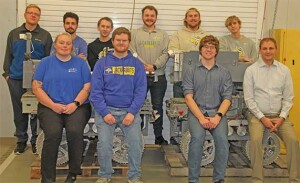NASA has narrowed the field to six in its lunar soil excavating contest, and a team of students from South Dakota State University is among the groups left in the hunt for a $1 million top prize.
Conceived in 2020, the Break the Ice Lunar Challenge tasked innovators with creating robotic systems that can navigate the rugged terrain of the Lunar South Pole, dig up its icy soil and transport it to another location, where, in theory, water could be extracted from the soil.
There were two earlier design and prototype phases in which SDSU advanced. In the latest stage, SDSU was one of 15 finalists invited to give their prototypes a 15-day test.
Nine entities completed the 15-day durability testing, attempting to have their equipment excavate up to 800 kilograms (1,760 pounds) of soil daily for 15 consecutive days and then document their work by video and lengthy reports, which were due Oct. 27. When NASA announced the six finalists, only one other was strictly composed of college students.
NASA awarded the top three places and added three runners-up, which included SDSU and Michigan Tech.
Todd Letcher ’05, an associate professor in the mechanical engineering department at SDSU, has overseen State’s effort, which has gone through three cycles of students.
“It’s tremendously exciting for current and former students who have worked on SDSU’s Space Trajectory team to be able to continue this challenge. I must admit it was driving me a little bit crazy waiting for the announcement. After NASA released the results, I probably got about 40 to 50 Slack pings in about an hour from past and current team members,” Letcher said.
NASA made the announcement Dec. 6, but Letcher said, “We have been preparing for this since the day we finished testing in mid-August and even before that.
“Throughout this contest, our teams have been comprised almost exclusively of undergraduate students. Many of our competitors were space company start-ups, and there were even a couple of international entities. I am tremendously proud of the dedication past students have given to this project, especially the handful that pushed the project though summer testing,” Letcher said.
Jason Sternhagen ’98/ MS ’01, an electrical engineering research associate who has worked side by side with Letcher, added, “This achievement really says a lot about the tenacity of our students and the excellent opportunities available at SDSU.”
The head-to-head finals will be held in June in Huntsville, Alabama.






